Themed collection Materials for energy storage and conversion: Chemical Science symposium collection

Challenges in the design and synthesis of self-assembling molecules as selective contacts in perovskite solar cells
We summarize the challenges to design and synthesize self-assembled molecules, discussing their synthetic routes and structural features in relationship to the efficiency of perovskite-based solar cells where they are applied as selective contacts.

Chem. Sci., 2024,15, 1534-1556
https://doi.org/10.1039/D3SC04668K
Fine tuning of electrosynthesis pathways by modulation of the electrolyte solvation structure
This Perspective article highlights how mastering the electrolyte structure, both in bulk and at the electrochemical interface, can provide an additional level of control for the rational design of electrosynthetic routes.

Chem. Sci., 2023,14, 7103-7113
https://doi.org/10.1039/D3SC01889J
Constructing nitrided interfaces for stabilizing Li metal electrodes in liquid electrolytes
In this perspective, we make a systematic summary and give out our comments on constructing nitrided interfaces for stabilizing Li metal electrodes.

Chem. Sci., 2021,12, 8945-8966
https://doi.org/10.1039/D1SC01806J
Towards green and efficient chemical looping ammonia synthesis: design principles and advanced redox catalysts
This review provides insights into the design and application of redox catalysts in chemical looping ammonia synthesis.

Energy Environ. Sci., 2024,17, 2381-2405
https://doi.org/10.1039/D4EE00037D
Organic electrolyte design for practical potassium-ion batteries
In this review, recent electrolyte design strategies and progress are given, along with the discussion of relative key features and properties, as well as the practical design and considerations.

J. Mater. Chem. A, 2022,10, 19090-19106
https://doi.org/10.1039/D2TA02223K
Participation of electrochemically inserted protons in the hydrogen evolution reaction on tungsten oxides
Tungsten oxides undergo a significant increase in their hydrogen evolution reaction activity upon proton-insertion coupled electron transfer.

Chem. Sci., 2024,15, 5385-5402
https://doi.org/10.1039/D4SC00102H
In situ electrochemical regeneration of active 1,4-NADH for enzymatic lactic acid formation via concerted functions on Pt-modified TiO2/Ti
Nicotinamide adenine dinucleotide (NAD+) and its reduced form (NADH) are key cofactors serving as essential hydrogen acceptors and donors to facilitate energy and material conversions under mild conditions.

Chem. Sci., 2024,15, 3240-3248
https://doi.org/10.1039/D3SC04104B
Alkaline-earth ion stabilized sub-nano-platinum tin clusters for propane dehydrogenation
Ca-stabilized sub-nano-platinum–tin clusters for efficient propane dehydrogenation are constructed, and the presence of Ca modulates the properties of Pt by influencing the reduction extent of Sn species.

Chem. Sci., 2024,15, 1046-1050
https://doi.org/10.1039/D3SC04310J
Understanding the evolution of double perovskite band structure upon dimensional reduction
We explain the orbital basis for the bandgap transition with dimensional reduction seen in certain double perovskites and predict which compositions are likely to show this effect.

Chem. Sci., 2023,14, 11858-11871
https://doi.org/10.1039/D3SC03105E
Accessing complex reconstructed material structures with hybrid global optimization accelerated via on-the-fly machine learning
This paper describes a multi-tribe hybrid evolutionary algorithm that combines differential evolution and genetic algorithms for surface structural optimization accelerated by an on-the-fly machine learning calculator.

Chem. Sci., 2023,14, 8777-8784
https://doi.org/10.1039/D3SC02974C
Emerging indoor photovoltaics for self-powered and self-aware IoT towards sustainable energy management
IoT devices powered by copper electrolyte-based dye-sensitized photovoltaic cells as ambient light harvesters achieve 38% power conversion efficiency and incorporate a dynamic intelligent on-device energy management system.

Chem. Sci., 2023,14, 5350-5360
https://doi.org/10.1039/D3SC00659J
Reliably obtaining white light from layered halide perovskites at room temperature
Addition of bromide to 2D lead-chloride perovskites appears to be a general and reliable strategy for obtaining white light at room temperature from 2D perovskites, regardless of templating effects of the organic cations.

Chem. Sci., 2022,13, 9973-9979
https://doi.org/10.1039/D2SC02381D
Mixed lead–tin perovskite films with >7 μs charge carrier lifetimes realized by maltol post-treatment
Maltol, a metal binding agent, effectively passivates defects on the surface of mixed lead–tin perovskite films. The carrier lifetimes of the resultant perovskite films are over 7 μs. The solar cell devices exhibit efficiencies of up to 21.4%.

Chem. Sci., 2021,12, 13513-13519
https://doi.org/10.1039/D1SC04221A
Trapped interfacial redox introduces reversibility in the oxygen reduction reaction in a non-aqueous Ca2+ electrolyte
An interlayer product of oxygen reduction with Ca2+/TBA+ yields a quasi-reversible oxygen evolution reaction by inducing a trapped interfacial redox process.
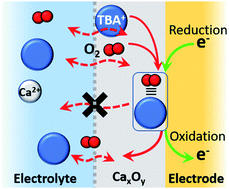
Chem. Sci., 2021,12, 8909-8919
https://doi.org/10.1039/D0SC06991D
Redox mediators accelerate electrochemically-driven solubility cycling of molecular transition metal complexes
We present an example of electrochemically-driven solubility cycling of a molecular transition metal complex and report a novel strategy for catalytically enhancing the oxidation of an insoluble material using homogeneous redox mediators.

Chem. Sci., 2020,11, 9836-9851
https://doi.org/10.1039/D0SC02592E
Weakly solvating aqueous-based electrolyte facilitated by a soft co-solvent for extreme temperature operations of zinc-ion batteries
The weakly solvating electrolyte achieves optimized interface chemistry and good temperature adaptability for aqueous zinc ion batteries.

Energy Environ. Sci., 2024,17, 4569-4581
https://doi.org/10.1039/D4EE00942H
Exploring carbon electrode parameters in Li–O2 cells: Li2O2 and Li2CO3 formation
Different discharge products were revealed in Li–O2 batteries with different carbon cathodes by operando Raman and ex situ Raman and XPS measurements. In a carbon paper electrode Li2O2 is formed, while for electrodes with CNT, Li2CO3 and Li2O2 were noticed in different discharge stages.

J. Mater. Chem. A, 2024,12, 7215-7226
https://doi.org/10.1039/D3TA07701B
Mechanistic understanding of microstructure formation during synthesis of metal oxide/carbon nanocomposites
In situ analysis of physicochemical processes occurring during pyrolysis synthesis of a TMO/C nanocomposite, including microstructure analysis via (S)TEM. Characterization of materials as electrodes for lithium intercalation and conversion reactions.

J. Mater. Chem. A, 2023,11, 17125-17137
https://doi.org/10.1039/D3TA01230A
Effect of PEIE and polylysine as interfacial layers on the performance of air-processed organic solar cells under both indoor and 1 sun conditions
Interfacial layers improve organic solar cells performance, but they behave differently in low light intensities respect to 1 sun. This study highlights the importance of selecting the right IFLs to suppress leakage current and enhance efficiency.

Sustainable Energy Fuels, 2023,7, 3316-3325
https://doi.org/10.1039/D3SE00242J
The role of ion solvation in lithium mediated nitrogen reduction
Since its verification in 2019, there have been numerous high-profile papers reporting improved efficiency of lithium-mediated electrochemical nitrogen reduction to make ammonia.

J. Mater. Chem. A, 2023,11, 12746-12758
https://doi.org/10.1039/D2TA07686A
All-blade-coated flexible perovskite solar cells & modules processed in air from a sustainable dimethyl sulfoxide (DMSO)-based solvent system
Sustainable flexible perovskite solar modules that are deposited without toxic solvents are developed via blade coating in ambient air. 14% PCE is obtained by the optimization of coating parameters and the use of additives.
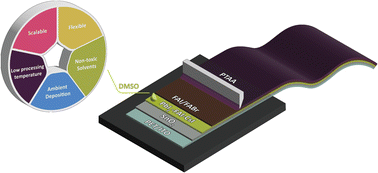
Sustainable Energy Fuels, 2023,7, 2219-2228
https://doi.org/10.1039/D2SE01678H
Optimized carrier extraction at interfaces for 23.6% efficient tin–lead perovskite solar cells
This work provides an efficient way to facilitate both electron and hole extraction in the designated interfaces of perovskite solar cells. A record power conversion efficiency of 23.6% for mixed Sn–Pb perovskite solar cell devices is realized.
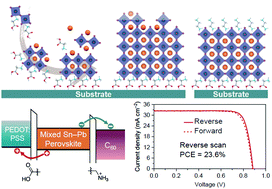
Energy Environ. Sci., 2022,15, 2096-2107
https://doi.org/10.1039/D2EE00288D
Copper coordination polymers with selective hole conductivity
Low-dimensional copper coordination polymers represent an alternative, unprecedented class of charge transport materials, comprised of molecular building blocks.

J. Mater. Chem. A, 2022,10, 9582-9591
https://doi.org/10.1039/D2TA00267A
Understanding and suppressing non-radiative losses in methylammonium-free wide-bandgap perovskite solar cells
We identify the limiting factors of wide bandgap metal halide perovskite solar cells. To overcome these losses, we developed an efficient optimisation strategy and outline the necessary steps for the continued development of these perovskites.
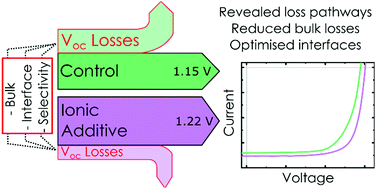
Energy Environ. Sci., 2022,15, 714-726
https://doi.org/10.1039/D1EE02650J
Shelf lifetime analysis of organic solar cells combining frequency and time resolved techniques
Combined impedance spectroscopy and photovoltage/photocurrent transient techniques with dark J–V modelling was employed to study the shelf ISOS-D1 stability of organic solar cells.
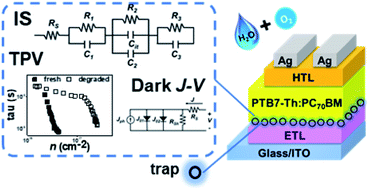
Sustainable Energy Fuels, 2021,5, 6498-6508
https://doi.org/10.1039/D1SE01107C
Understanding the perovskite/self-assembled selective contact interface for ultra-stable and highly efficient p–i–n perovskite solar cells
We have designed and synthesised two new carbazole based self-assembled molecules as hole-selective layers (HSLs) in p–i–n perovskite solar cells achieving high efficiency and high stability.
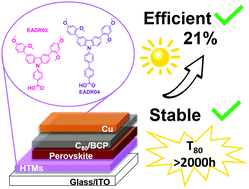
Energy Environ. Sci., 2021,14, 3976-3985
https://doi.org/10.1039/D0EE03807E
About this collection
Materials for energy storage and conversion is the theme of this years’ Chemical Science symposium, which in 2024, is joint with the Chemical Society of Japan (CSJ). The RSC and the CSJ have collaborated on many activities in the past, and we are excited to welcome the energy materials community to the home of the RSC for this year’s Chemical Science symposium.
To celebrate our excellent international speakers and committee members, we have selected some of their recently published work in Chemical Science, and our other relevant RSC journals: Energy & Environmental Science, Journal of Materials Chemistry A and Sustainable Energy & Fuels. We hope you enjoy reading these articles and look forward to welcoming you to London either in-person or virtually in October!